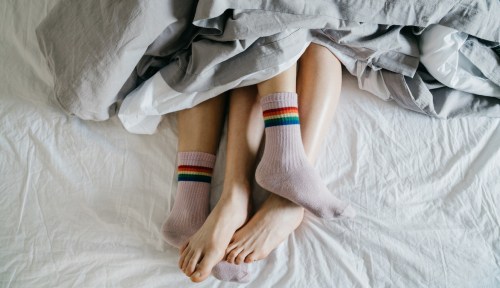A growing interest toward striking a tone of sexual inclusivity has been great for starting important conversations, cultivating an improved sense of normalcy, and increasing acceptance for who has sex with whom. But there’s still a lot of knowledge to spread and confusion to clear. One place in particular is the question of what does asexual mean, especially in the scope of a relationship.
To start, asexuality describes a lack of sexual interest or desire, rather than being based on whom you want to be having sex with. “Lots of people hear about asexuality and assume it’s made up, which is silly because that’s how I identify,” zero-waste blogger Milo Rusnak tells me. In general, there is a lack of understanding around what it means.”
To that point, sexuality experts and people who identify on the asexuality spectrum answer below what does asexual mean, what it does not, and what romantic and/or sexual relationships within that community.
Asexuality: What it is and what it’s not
According to the Asexual Visibility and Education Network (AVEN), “An asexual person does not experience sexual attraction. They are not drawn to people sexually and do not desire to act upon attraction to others in a sexual way.”
While studies to quantify exact data are limited, psychotherapist and sex coach Carlos Cavazos, MA, LPC, says that current research points to about 1 percent of the population identifying as asexual. “These estimates rely on self-reporting, and since asexuality is not well-understood by most people, there is a possibility of the number being smaller or larger.”
What asexuality isn’t is something you can develop, courtesy of obligations like, say, a monthlong visit from the ‘rents or a Google Cal that looks like a losing game of Tetris. Those instances may cause a dip in libido—which surely can be frustrating, especially for a partner who has a higher sex drive. Still, a lack of fire is not the same as asexuality. “Low libido and asexuality are not synonymous,” says sexologist Jill McDevitt, PhD.
“A simple way to differentiate a low libido or celibacy from asexuality is to think about it like this: Libido is something you have, celibacy is your behavior, asexual is something you are.”—psychotherapist and sex coach Carlos Cavazos
A low libido could be an effect of many different things—like a health issue, medications, or a number of other reasons—and is generally regarded as something to work on or improve (aka increase), but asexuality is neither caused by anything nor something to be fix. It’s an identity. As AVEN notes, “asexuality is an intrinsic part of who we are, just like other sexual orientations.”
Rusnak agrees: “People tend to assume that something terrible happened to me that ‘made’ me asexual,” says Rusnak. “Sure, I’ve had some bad experiences, but I identified as asexual since long before then. While some people do find themselves uncomfortable with sex after a traumatic experience and may adopt the label to describe themselves (either permanently or temporarily), I think it’s important to realize that not every asexual person has been traumatized.”
Furthermore, asexuality is not synonymous with celibacy. Celibacy is actively not engaging sex (however the person in question defines sex). Someone who is celibate does not necessarily lack a desire (now, in the future, ever) to have sex the way someone who is asexual does, says Cavazos. Plus, while asexual folks don’t experience sexual desire, they still often have sex (more on this below). “A simple way to differentiate a low libido or celibacy from asexuality is to think about it like this: Libido is something you have, celibacy is your behavior, asexual is something you are,” says Cavazos.
Speaking of sex, people who identify as asexual may still masturbate. Asexuality doesn’t bar anyone from reveling in the health benefits associated with orgasms by way of masturbation (like glower skin and reduced stress), Cavazos says.
Sexual orientation ≠ romantic orientation
Did you know that every individual has both a sexual orientation and a romantic orientation? “Most people don’t think about this distinction because their sexual orientation is in line with their romantic orientation,” says Cavazos. For example: A straight male who wants to have sex with a woman and a lesbian who wants to have sex with a woman both have a sexual orientation that aligns with their romantic orientation.
A romantic orientation, as Cavazos explains it, is “who we want to date, kiss, cuddle, be lovey-dovey with…. It’s who we want to romance and who we want to romance us.” Just as you can be heterosexual, homosexual, bisexual, and asexual, you can be heteromantic, homoromantic, biromantic, and aromantic, he says. “Someone who is aromantic has no desire to form a romantic, emotional relationship with anyone.” So identifying as an aromantic heterosexual person, for example, means you’re interested in engaging sexually but not romantically with people of the opposite sex. Alternatively, someone who is asexual and heteromantic might say the opposite.
Aromanticism and asexuality don’t always go hand-in-hand.
Asexuality activist, Yasmin Benoit, identifies as asexual and aromantic: “’aromantic’ because I don’t experience any romantic attraction or interest, and ‘asexual’ because I don’t experience sexual attraction or interest,” she says. “I’m a friendship-oriented person. I put a lot of energy and investment into friendships. I’ve always said that I’d much prefer to have the Ron to my Harry rather than a Prince Charming.”
But aromanticism and asexuality don’t always go hand in hand, says Cavazos. “A person who identifies as asexual may also identify as heteromantic, homoromantic, or biromantic.” For instance, Rusnak identities not just as asexual, but also as queer and biromantic. “Asexuality is a more personal indication of my sexual desire, and it’s something only my close friends and partners know. The biromantic part of my identity defines who I’m attracted to and is what influences what my settings are in dating apps.”
All of this is to say that people who identify as asexual can certainly be in romantic relationships.
Asexuality in romantic relationships
“Asexual people who are not aromantic can be in happy relationships with either asexual or non-asexual people,” Rusnak says. “I’m in a long-term romantic relationship with a non-asexual person. We live together and have been dating for two years.”
Wondering how the heck this can be possible is kind of like asking “what’s the right amount of sex to be having?” Every single person is going to have a different answer because there’s no singular asexual experience. It all depends what both partners are looking for.
Take Rusnak’s situation for example: “I’m asexual, but I don’t hate sex,” she says. “I’m comfortable having sex. So although I don’t feel much sexual attraction ever, I still remind myself of its significance to my partner (who is not asexual). I frame it in my mind as a bonding experience and focus on the emotional connection involved. And my partner knows this.”
But she’s quick to reiterate that how personalized and varied the asexuality spectrum is. “My experience is definitely not the same as everyone else’s,” she says. “For instance, some couples have boundaries set up that allow the non-asexual partner to seek sexual fulfillment elsewhere. That might be opening up the relationship, being okay with flings, or even opening yourselves up to a polyamorous relationship.”
Basically, so long as as both partners are operating within the bounds of consent, any monogamous, monogamish, or other arrangement can work and be healthy. “As with any relationship, the key is for both partners to communicate their needs and what’s needed to fulfill them,” says Rusnak.
Confused about other aspects of sex? Here’s what 10 real women of different relationships statuses and sexual preferences think about about porn. Plus, here’s whether or not there’s a thing as too much sex.
Sign Up for Our Daily Newsletter
Get all the latest in wellness, trends, food, fitness, beauty, and more delivered right to your inbox.
Got it, you've been added to our email list.











